Guest Post by David Stockman

Keynesians never say I’m sorry—they just make excuses until they can cherry-pick data to show that their destructive policies are working. In this respect our tiresome Keynesian school-marm, Janet Yellen, was in fine fettle upon the Friday jobs report, announcing that a “soft landing” had been achieved. Everything is now hunky-dory on main street, said she, because wages were up by 4.1% versus an estimated 3.2% rise in headline inflation for the 2023.
Let’s see. Here are the values for average hourly wages and the headline CPI indexed to December 2020. As it has transpired, since Yellen and the Biden puppeteers purportedly took over economic policy, the cost of living (black line) has risen 25% more than the average hourly wage (purple line).
Change In CPI Versus Average Wage Since December 2020
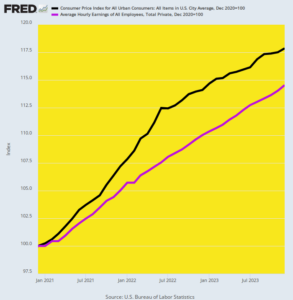
Then again, our paint-by-the-numbers monetary central planners apparently believe that the world starts anew every month, quarter and year and that there is no such thing as the actual level of wages and prices. It’s all about the short-run rate of change. Since the inflationary battering of wages that has been underway for several years is now purportedly in the rearview mirror, apparently it just didn’t happen.
To be sure, a few years ago when the shortest inflation ruler available—the core PCE deflator—was running significantly below the Fed’s sacred 2.00% target, the Eccles Building was all for a catch-up of the level. The Fed even announced a policy of targeting inflation to average 2.0% over time, which ukase did not include, conveniently, the exact span of time to be measured.
The Federal Reserve now intends to implement a strategy called flexible average inflation targeting (FAIT). Under this new strategy, the Federal Reserve will seek inflation that averages 2% over a time frame that is not formally defined. This means that after long periods of low inflation, the Federal Reserve will not enact tighter monetary policy to prevent rates higher than 2%. One benefit of this flexible strategy to managing the mandate of price stability is that it will impose fewer restrictions on the mandate of full employment.
Wouldn’t you know it? The Fed switched to “averaging” in August 2020—just months before inflation went soaring to levels not seen since the 1970s. Perhaps they should have held some of this dry powder in reserve rather than keeping their foot on the monetary accelerator in a very badly timed effort to average-up.
Besides that, the reliably stable 16% trimmed mean CPI had actually posted at +2.4% Y/Y in August 2020, and had been above the 2.00% target for 37 of the prior 48 months. And yet the Fed heads insisted on looking a gift horse in the mouth, blathering tediously about missing their inflation target from below and needing to average-up by running the printing press even hotter.
Of course, prior to 1990 or even later, no one would have ever faulted a central bank for creating too little inflation. Yet during the current century—when the Fed and other fellow-traveling central banks of the world have taken their balance sheet from $3 trillion to $44 trillion–we have had the risible condition of central bankers complaining that the US economy was being hurt because their wasn’t enough inflation!
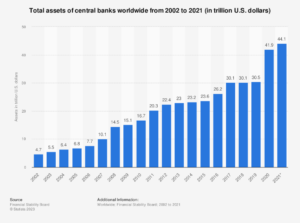
Needless to say, our Keynesian pointy-heads had a weird notion of too little inflation. Just in the period between the de facto adoption of 2% inflation targeting around the turn of the century and the shift to averaging under FAIT in August 2020, the dollar’s purchasing power had dropped by nearly 35%.
To claim that the US economy required even more of that kind of monetary depreciation required a leap of logic that the Fed heads have never, ever acknowledge. To wit, that all sectors of the economy and individual households alike ride the good ship inflation in equal lockstep.
Purchasing Power Of Consumer Dollar, January 2000 to August 2020
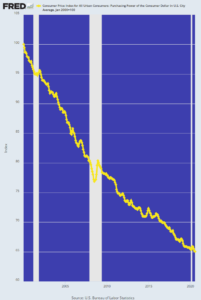
Alas, that is not remotely true. For instance, since January 2000, average hourly earnings in the heavily-import impacted manufacturing sector have risen by 92%. But among the quasi-cartels in the private education and health sector, wages have gone up by 124%.
Yes, there is such a thing as relative price change in the labor market, but the point nevertheless holds true: Manufacturing workers competing with newly minted industrial workers from the rice paddies of China were in a far weaker position to absorb the Fed’s 2.00% inflation gift than were workers drawing paychecks from the massively state-subsidized health and education sectors.
And, of course, when it comes to savers and retirees, we are talking about pure confiscation of wealth. The CPI rose by 83% during that 23-year period, but a $1,000 savings account in the year 2000 would have been worth only $1,520 by 2023 with fully reinvested money market interest payments.
So we do mean confiscation. In combination, the Fed’s idiotic inflation targeting along with its ZIRP interest rate policy during most of the period would have resulted in a 17% reduction in the purchasing power of this savings account.
Change In Average Hourly Earnings Since January 2000: Manufacturing Versus Education And Health Services
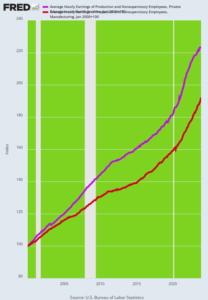
Now, of course, the Eccles Building is being urged by Wall Street and the Biden Administration alike to go back to de-averaging. That is, to fuggedabout the vast inflation overshoot of the last several years and on the basis of forecast inflation in the 2-3% vicinity declare victory over inflation and get on with the real business of the Fed, which is to cut interest rates to the vanishing point in order to fuel another liquidity-fueled mania on Wall Street.
Still, the screaming inconsistency cannot be gainsaid. A few years back they were complaining about “lowflation” owing to missing the target on one measure—the PCE deflator—by a modest fraction of an integer, but now bygones are to be bygones. After an inflation shock has cut the value of average hourly wages and savings quite sharply, the Keynesians are lathering up for a new flood of bad money.
Y/Y Change In 16% Trimmed Mean CPI, August 2016 to August 2022
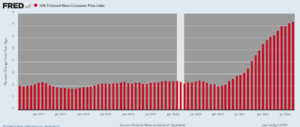
But we would say, not so fast. In November, the 12-month moving average of of the median hourly wage (dashed yellow line) was still up by +5.6% on a Y/Y basis. That’s higher than anything posted since December 1997 prior to the current inflation surge.
Likewise, the 3-month moving average (purple line) of the same measure posted at +5.2% in November—again still well above the trend of the past two decades.
Yet if median wage gains are still grinding well above 5% Y/Y and the 12-month moving average has only come down from the March 2023 peak of 6.4% to 5.6% we’d contend that the inflation victory dances are coming a tad too soon.
Median Hourly Wage Increase, 3-Month and 12-Month Moving Averages, December 1997 to November 2023
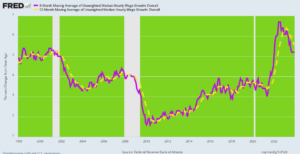
To remind, nonfarm labor productivity growth has stalled-out badly in recent quarters, and in Q3 2023 stood at the same level it had posted in Q1 2021. In the face of 5%+ growth in median wages and zero net productivity gain, therefore, the odds that unit labor cost growth is going to settle down to anything close to 2.0% anytime soon is somewhere between slim and none.
Index Of Nonfarm Labor Productivity, Q1 2021 to Q3 2023

The above chart is not only a reminder that there has been no Fed victory over inflation at all, but also why 2.00% inflation targeting is such unmitigated nonsense.
Supposedly, a little bit of steady, predictable inflation will help improve macroeconomic performance—specifically by improving the Phillips Curve trade-off between employment and inflation. But the November jobs report is a reminder that this core feature of Fed policy thinking is also threadbare, to put it charitably.
Fully 183,000 or 85% of the 216,000 new jobs reported for December 2023 were in the low-pay, low-productivity sectors of government, leisure & hospitality, retail trade and health and education services. Indeed, owing to the short weekly hours in many of these sectors, the index of aggregate hours worked actually declined during December from the November level.
That’s right. The actual deployment of labor hours in the nonfarm economy shrank during December, notwithstanding the ballyhooed 216,000 gain in the nonfarm headcount.
Of course, there is a clear solution to this stumbling around with inflation and full-employment targeting by the Fed. To wit, it needs to go back to its original mission of functioning as a liqudity backstop to the commercial banking system, and dispense with the Mission Impossible of fine-tuning the macro-economic outcomes of a $26 trillion national economy, which, in turn, is deeply and opaquely integrated into the flow of goods, services, wages, capital and finance within the planet’s now $104 trillion economy.
In short, let the Fed take care of banking system liquidity on an unsubsidized basis. In turn, allow the private economy to produce the level of output, jobs, housing and business investment the free market is capable of generating at any given time and under whatever foolish or not so foolish policy constraints that may be imposed by the politicans and state apparatchiks.
As for inflation, once the Fed gets out of the “stimulus” and Phillips curve trade-off business, there wouldn’t be any inflation on a trend basis. That’s because the Fed would no longer be goosing aggregate demand via fiat credit expansion. The only new central bank credit that would enter the financial system would be Discount Window advances collateralized by goods already produced or sold.
In a word, money would be regulated indirectly by the ebb and flow of production and commerce on the free market. While revival of this “real bills” based central banking model would not be a perfect monetary system short of return to the gold standard, it would be one hell of an improvement over the doings of the 12 stumble-bum monetary central planners who comprise the FOMC.
Editor’s Note: Unfortunately, there’s little any individual can practically do to change the trajectory of this trend in motion. The best you can do is to stay informed so that you can protect yourself in the best way possible, and even profit from the situation.
Most people have no idea what really happens when a currency collapses, let alone how to prepare…
How will you protect your savings in the event of a currency crisis? This just-released video will show you exactly how. Click here to watch it now.
It is my sincere desire to provide readers of this site with the best unbiased information available, and a forum where it can be discussed openly, as our Founders intended. But it is not easy nor inexpensive to do so, especially when those who wish to prevent us from making the truth known, attack us without mercy on all fronts on a daily basis. So each time you visit the site, I would ask that you consider the value that you receive and have received from The Burning Platform and the community of which you are a vital part. I can't do it all alone, and I need your help and support to keep it alive. Please consider contributing an amount commensurate to the value that you receive from this site and community, or even by becoming a sustaining supporter through periodic contributions. [Burning Platform LLC - PO Box 1520 Kulpsville, PA 19443] or Paypal
-----------------------------------------------------
To donate via Stripe, click here.
-----------------------------------------------------
Use promo code ILMF2, and save up to 66% on all MyPillow purchases. (The Burning Platform benefits when you use this promo code.)






Auntie wonders if Mr. Stockman, thinks the U.S.A.’s $hituation is salvageable at this juncture or not?
At one $ trillion a year in vigorish alone…wait ’til it goes vertical.
Vertical approaches quickly. We’ll have close to $40T in debt in about 18 months. At 5%, that’s $2T in “vig”.
Yeah, we’re toast.
LOL, I thought you wrote “puncture” not juncture at first, like puncture the bubble! And no, that will not be salvageable. We will have a new dictatorial government and a new much more controllable form of trade than our current money.
Where did thirty years of productivity gains go? Not to the US worker. Somehow working smarter and harder has given us no private sector job security but also a collapsing standard of living. Small biz decimated.
Most are but a half-step ahead of the ever expanding, ruling blob that will consume it all.
Where did the money go, here:
The Five Richest Men Have Doubled Their Wealth Since 2020
The wealthiest of the wealthy have more than doubled their fortunes to $869 billion in 2024 from $405 billion in 2020, a 114% increase, a new study shows.
That would be basically 2021,2022, and 2023, look for it to continue in 2024, Biden’s term.
The five richest men in the world are now twice as rich; good news for billionaires, bad news for everyone else. – kiplinger published 16 days ago
Not only have the five richest growth their net worth to a number inching closer to $1 trillion, but billionaires in general are $3.3 trillion richer than in 2020, with their wealth growing three times faster than the rate of inflation. The report was compiled by OxFam, using data from Forbes.
Bidenomics is fantastic if you are a billionaire, and they called Trump billionaires friend!
WWZ
As a victim you should get a gun and get your share of elonis wealth
They should portray these statistics using stacks of Matzah Balls…a tribute to our rulers and a more fitting and entertaining portrayal of our current problem.
We uns gonna take what dey gibs so to say. Dey be bein’ very much mo’ smawtah an mo’ eddykaded dan us’ns.
In a real sense increasing productivity ought produce declining prices relative to flat wages. Fluctuations in wage rates would be seen due to local conditions-availability of suitable labor and local advantage- holistic increases in wage rates come only through debasement of currency and always FOLLOW, never LEAD the price increases caused by such debasing of the currency allowing a larger skim by the non-productive rentier class under which we suffer. See above.